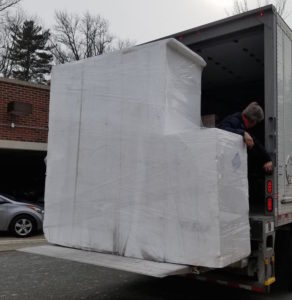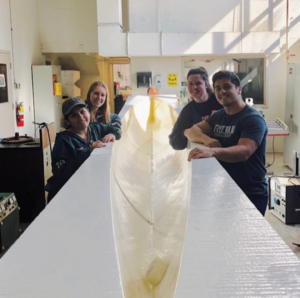Welcome to Your SUPER-powered WP Engine Multisite Install. This is your first post. Edit or delete it, then start blogging!
Mesh Locked Tips Update 4/14/18
After the foam tips were shaped to the proper form, the installation took place. When installing the reinforcing mesh, the team purposefully left extra mesh material on both tips of the canoe so that the foam could later be wrapped in the mesh. The foam was set in the tips and wrapped in the mesh and finally the unit as a whole was encased in the same concrete mix as the rest of the canoe.
Foam Tip Update 4/10/18
The team decided to utilize the allowance of foam tips in the construction of Triton. According to ASCE 2018 Rules and Regulations, the canoe can be constructed with foam tips that extend 2 feet inward from both the front and back tips of the canoe. Using recycled material from previous years, the foam was measured and cut to fit the mold. The team used a file to best mimic the shape of the canoe.
March 3/31 Fabrication Update
The TCNJ canoe team has had its most challenging week yet. Attached is a time lapse of all five members constructing the canoe. First the three piece female mold was bounded by tape the plastic tarp was put over the ‘cracks’ for a smooth finish. Two mixes were made to make the first layer then mesh was overlaid. Two more mixes were made to put over the mesh. After the concrete set the foam tips were constructed then encased in concrete. Later in the week the ASCE technical report and technical addendum were drafted and completed.(https://www.youtube.com/watch?v=l4FCcU1Nq1U)
March 3/31 Mix Design Update
The Concrete Canoe Mold Has Arrived! 2/14/18
Final Steps for TCNJ Triton! 2/13/18
The canoe team is awaiting their mold while fixing a minor problem with the mix design. The TCNJ, ASCE, and engineering notebook reports are underway. With the free time the hull design has, Raquel and Charlotte have been working on ordering mesh and displaying the canoe. We cannot wait to compete!
Hull Design Winter Break Update 1/22/18
The Hull Deign Team has been making crucial progress toward selecting dimensions of the canoe. Having completed the research on the shapes and features of the canoe, the team is able to focus on comparing and analyzing the total length and beam width combinations of different canoes. The team has come up with 16 potential design alternatives that will be compared to one another for stability and resistance. The mold has been ordered and the final product is about to be constructed!
Mix Design Winter Break Update 1/22/18
The mix design team is finalizing their skin layer mix. This step is critical because if the specific weight of the skin layer is too high, then the two concrete layers together may have a greater specific gravity than water. In order to ensure construction begins on time, the mix design team has been in the lab during winter break preparing both concrete mixtures. Currently, the core and skin layer without the waterproofing admixture is curing for 1 week and will be tested for its specific weight and compressive strength on Thursday, January 18th. After these two quick tests, it will be determined if the core mix will need more Elemix in order to decrease the canoe specific weight so it is less than that of water, 62.4 pcf. On this date, the last concrete cubes will be made to ensure the final mixes that are chosen will be suitable for the canoe.
Hull Design 11/21/17
The Hull Deign Team has been making crucial progress toward selecting dimensions of the canoe. Having completed the research on the shapes and features of the canoe, the team is able to focus on comparing and analyzing the total length and beam width combinations of different canoes. The team has come up with 16 potential design alternatives that will be compared to one another for stability and resistance. Stay tuned for the final designs!


